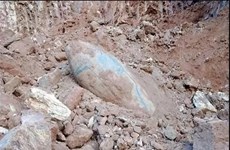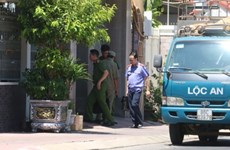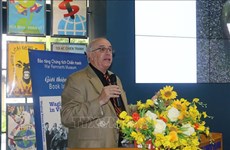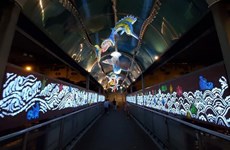66 million USD to be spent on traffic jams
Hanoi plans to invest more than 1.2
trillion VND (66 million USD) in reducing traffic jams and accidents
during the 2011-15 period.
Hanoi plans to invest more than 1.2
trillion VND (66 million USD) in reducing traffic jams and accidents
during the 2011-15 period.
The five-year project is expected to help ensure improved traffic flow and reduce the number of traffic accidents and fatalities by 7 percent from previous years.
There were 1,207 traffic accidents in Hanoi in 2009 accounting for 865 deaths, a drop of 1.1 percent and 0.35 percent in the number of traffic accidents and fatalities, respectively, according to a report from the Hanoi Traffic Police.
Of the total investment capital, which is expected to come from Official Development Assistance, the State budget, traffic violation punishment funds and other sources, more than 440 billion VND (23.3 million USD) will be used to develop traffic infrastructure within the city.
It will focus on upgrading 75 black spots which often suffer from serious traffic congestion, and 117 sites where severe accidents often take place, while upgrading facilities for pedestrians and developing public transport infrastructure.
These hot spots include sections in Pham Van Dong, Hoang Hoa Tham and Thuy Khue in the west of Hanoi and Minh Khai, Linh Nam and De La Thanh streets in southeastern of the city.
The money will also be invested in installing speed limitation signs and warning equipment; expanding roads, particularly at dangerous junctions and building pedestrian bridges.
Meanwhile, over 385 billion VND (20.4 million USD) will be used for traffic organisation and management as part of the project.
The remaining capital will be used for training and information, focusing on modernising human resources, improving the capacity of traffic control forces and raising public awareness.
The project is scheduled to be submitted to the municipal People's Committee for approval this month.
Transport experts agreed that a rapid increase in vehicles coupled with bad urban planning are the major reasons for traffic jams and accidents.
Chief inspector of the municipal transport department Thach Nhu Sy said a rapid increase in apartment buildings has drawn a large number of people from other provinces to the city.
"However, investment in building infrastructure such as roads, water drainage systems and electricity supplies is limited, straining Hanoi 's traffic network," he said.
He admitted that the city's traffic infrastructure had failed to keep up with the increased traffic and growth in urban areas.
Recent measures to prevent traffic congestion and accidents for the capital city had proved effective in reducing traffic jams, but they failed to solve the problem during festivals, holidays and rush hours, Sy added.
Nguyen Huu Duc, an expert from the Japan International Cooperation Agency (JICA) who jointly helped prepare the plan, said that some previous traffic projects that targeted traffic jams and accidents were not really successful.
Takagi Michimasa, a traffic safety expert from JICA, added that an outdated signal system was also to blame for the problem.
The traffic system should be computerised to help traffic police work better, he suggested.
Authorities should also coordinate with urban developers in tackling the problem, he said, adding that when high-rise buildings are built in the city, investment should be poured in building traffic infrastructure such as parking areas and roads he said.
The project has been developed by the municipal Department of Transport, Hanoi Traffic Police and Hanoi Popularisation and Education Committee with assistance from JICA expert team./.
The five-year project is expected to help ensure improved traffic flow and reduce the number of traffic accidents and fatalities by 7 percent from previous years.
There were 1,207 traffic accidents in Hanoi in 2009 accounting for 865 deaths, a drop of 1.1 percent and 0.35 percent in the number of traffic accidents and fatalities, respectively, according to a report from the Hanoi Traffic Police.
Of the total investment capital, which is expected to come from Official Development Assistance, the State budget, traffic violation punishment funds and other sources, more than 440 billion VND (23.3 million USD) will be used to develop traffic infrastructure within the city.
It will focus on upgrading 75 black spots which often suffer from serious traffic congestion, and 117 sites where severe accidents often take place, while upgrading facilities for pedestrians and developing public transport infrastructure.
These hot spots include sections in Pham Van Dong, Hoang Hoa Tham and Thuy Khue in the west of Hanoi and Minh Khai, Linh Nam and De La Thanh streets in southeastern of the city.
The money will also be invested in installing speed limitation signs and warning equipment; expanding roads, particularly at dangerous junctions and building pedestrian bridges.
Meanwhile, over 385 billion VND (20.4 million USD) will be used for traffic organisation and management as part of the project.
The remaining capital will be used for training and information, focusing on modernising human resources, improving the capacity of traffic control forces and raising public awareness.
The project is scheduled to be submitted to the municipal People's Committee for approval this month.
Transport experts agreed that a rapid increase in vehicles coupled with bad urban planning are the major reasons for traffic jams and accidents.
Chief inspector of the municipal transport department Thach Nhu Sy said a rapid increase in apartment buildings has drawn a large number of people from other provinces to the city.
"However, investment in building infrastructure such as roads, water drainage systems and electricity supplies is limited, straining Hanoi 's traffic network," he said.
He admitted that the city's traffic infrastructure had failed to keep up with the increased traffic and growth in urban areas.
Recent measures to prevent traffic congestion and accidents for the capital city had proved effective in reducing traffic jams, but they failed to solve the problem during festivals, holidays and rush hours, Sy added.
Nguyen Huu Duc, an expert from the Japan International Cooperation Agency (JICA) who jointly helped prepare the plan, said that some previous traffic projects that targeted traffic jams and accidents were not really successful.
Takagi Michimasa, a traffic safety expert from JICA, added that an outdated signal system was also to blame for the problem.
The traffic system should be computerised to help traffic police work better, he suggested.
Authorities should also coordinate with urban developers in tackling the problem, he said, adding that when high-rise buildings are built in the city, investment should be poured in building traffic infrastructure such as parking areas and roads he said.
The project has been developed by the municipal Department of Transport, Hanoi Traffic Police and Hanoi Popularisation and Education Committee with assistance from JICA expert team./.













